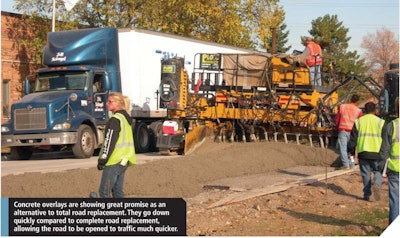
Concrete overlays
With little new construction going on because of the lack of a long-term highway funding bill, pavement preservation has become a priority for most agencies and municipalities. This is an area where concrete overlays are showing great promise.
“Concrete overlays have been around for a while, but within the last seven to eight years in particular, we’ve seen a tremendous growth in the use of the technology,” says Bill Davenport, vice-president of communications at the American Concrete Pavement Association (ACPA). “The downturn in the economy has played a part in that. Agencies are required to do more with less. They don’t have the money to do everything they’d like to do or everything they need to do, so that’s where the concrete pavement overlay comes into play.”
There are several types of concrete overlays that fall into two categories, bonded or unbonded. Within these categories, overlays are placed over distressed asphalt, concrete or composite pavements. One of the most common applications is bonded concrete over asphalt. In these applications, generally, the top 2 to 5 inches of the asphalt wearing course is milled off and replaced with concrete. The thin concrete overlay goes down quickly in comparison to complete road replacement, which allows the road to be opened to traffic much quicker.
“As an industry, we’re trying to educate agencies and contractors about the benefits of concrete overlays, as well as make them aware of potential applications,” Davenport says. ACPA is working through its staff engineers, affiliated associations and the National Concrete Pavement Technology Center to provide information and technical assistance but Davenport says there’s still work to be done. One example: the questions raised during a recent ACPA concrete overlay webinar. “They underscored the point that we still need to get the information out there on how to take advantage of concrete overlay technology, where the overlays can be used and the keys to building them right,” he says.
Stringless technology can play a big part in concrete overlays, making them easier to construct. A paver can use computerized electronic guidance systems and laser technology to control overlay thickness and smoothness and make adjustments as it moves along. “Stringless technology is taking hold with many contractors, as it makes the work site safer and helps improve final smoothness results when applied correctly,” Davenport says. “As we move forward, it is going to increase production and reduce some of the inconvenience to motorists.”Roller compacted concrete
Although not a new technology, roller compacted concrete (RCC) is still new to many people. It started out as a specialty product placed by specialty contractors, but there has been growing interest in its use in different applications, including turning lanes, low-volume streets and roads, parking lots, and also in limited highway applications such as on shoulders.
The National Concrete Pavement Technology Center published Guide to Concrete Overlays: Sustainable Solutions for Resurfacing and Rehabilitating Existing Pavements (3rd edition), which is available at cptechcenter.org.
The PCA publication, Guide for Roller-Compacted Concrete Pavements, is a guide specification for the construction of exposed RCC for roadways and other applications. It provides owners/agencies, contractors, and consultants with specification guidance aimed at setting and maintaining a consistently high standard for quality workmanship. It can be found at cement.org.
Another publication offered by the PCA is Guide to Full Depth Reclamation (FDR) with Cement, which can be obtained at members.cement.org.
The PCA also offers Guide to Cement Based Integrated Pavement Solutions. This guide provides a brief description on 10 specific engineering pavement applications. It is available at members.cement.org.
A collection of web- and desktop-based applications are available on the ACPA website. The apps are created to assist in the design, construction, and analysis of concrete pavements. These apps can be found at apps.acpa.org.
The ACPA offers two web-based training programs sponsored by the Federal Highway Administration. One covers safety in concrete construction work zones and the other covers stringless paving. This year, two more modules on best practices for constructing smooth concrete pavements and best practices for stockpile management will be unveiled. The courses are offered free of charge at acpa.org.
A Wikipave website is in the process of development by the ACPA. The online resource will offer information on all things related to concrete pavement technology, including products and technologies, as well as photos, charts, graphs, etc. Once the site goes live, anyone with a web connection will be able to access the information.
“Roller compacted concrete is an interesting paving material,” says Wayne Adaska, P.E., director of pavements at the Portland Cement Association (PCA). “It competes well with asphalt paving on cost and speed of construction. The zero-slump concrete, which uses no forms or reinforcement, is placed with asphalt-type pavers and then compacted to a high density using vibratory rollers.”
The key to RCC’s speed of construction is that it is placed in much thicker layers than asphalt. Where asphalt is placed in multiple layers of 3/4 to 2 inches, RCC is placed in single, thicker layers of up to 9 inches. Within the past five years, RCC has been embraced by many paving contractors who are getting involved because of the potential for the technology to replace asphalt, which has experienced sharp increases in cost.
One of the challenges RCC has faced is that the surface looks more like asphalt than concrete. It has an open texture, so those expecting the look of conventional concrete may be disappointed. “RCC is getting much better appearance wise,” Adaska says. “The top size aggregate has been reduced from 3/4 inch to as small as 1/2 inch, which results in a tighter surface texture; however, it’s still not at the stage where it looks like conventional concrete.”
To address the surface appearance, there’s an admixture available that shows great promise. The admixture is sprayed on the surface of the compacted RCC and then power troweled, resulting in a smoother, tighter surface. Last summer, the admixture was used on a project in the Chicago area. So far, Adaska says, the results have been outstanding, but it’s important to see how it holds up through the winter. Adaska believes admixtures, in general, will play a greater role in RCC in the future.
For several years, the ACPA has been leading the charge on improving the workmanship and quality of RCC. In early 2011, the association formed a task force made up of experts who have been providing guidance in advancing RCC, both technically and in market development.
Full depth reclamation
With preservation and rehabilitation on the minds of public agencies these days, there has been a renewed interest in full depth reclamation (FDR). Although not part of the concrete pavement family, FDR is one of the most sustainable paving products in the market place, since it preserves everything in place. This 30-year-old technology has been revolutionized in today’s market by larger, more powerful equipment. Reclaimers, or pulver mixers, have been the key component in revitalizing the market by expediting construction and making FDR economical.
FDR used to be a time-consuming job. Reclaimers had to make multiple passes to break up the old road, and special equipment such as rippers and breakers were required to make the material usable. Today, reclaimers can pulverize the asphalt and granular base in just one pass, going as deep as 18 inches. Cement is then spread, and the material is remixed, water added, if necessary, compacted, and cured. The result is a strong durable base that is constructed quicker and more economically, and is much more sustainable than removing and replacing the existing road. The base is suitable for concrete or asphalt pavement surfaces.
Maintenance of traffic
An emerging focal point for the concrete pavement industry is maintenance of traffic in construction work zones. “Agencies are under tremendous pressure to start and complete projects quickly, so, increasingly, contractors are required to keep traffic moving around work zones and avoid disrupting and delaying road users to the greatest extent possible,” Davenport says. “This is an area where the national association, along with local chapters, state paving associations and contractors will work together with agencies to find additional solutions.”












